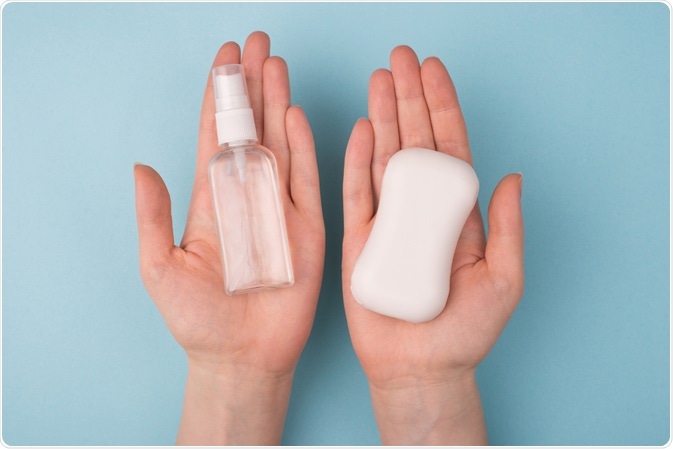 Image Credit: Inspiration GP / Shutterstock.com
Image Credit: Inspiration GP / Shutterstock.comWhy is hand hygiene important in the COVID-19 pandemic?
Our hands can be a critical vector in the transmission of infectious organisms. Infectious viruses can persist on surface materials for several days and are easily transferred between surfaces and hands upon contact.
When we touch our face, the infectious pathogens can enter the body through mucus membranes in our mouths, eyes and nose, and travel to the throat and lungs. Given that the average adult touches their face approximately 20 times per hour and is particularly likely to rub the noses or eyes, it is clear why hand hygiene has received renewed attention during the COVID-19 pandemic.
What are the Recommended Preventative Measures for COVID-19?
Practicing good hand hygiene is a simple preventative strategy that most people can easily undertake, and many studies have demonstrated the effectiveness of hand hygiene in preventing the transmission of infectious pathogens, including respiratory diseases. There is a vast array of different hand hygiene products on the market, many of which were in short supply globally at the outset of the COVID-19 pandemic following a surge in demand from consumers.
Key times to clean hands
Pre-pandemic, public health systems have communicated that hand cleaning should take place before and after preparing and eating food, before and after wound treatment, after using the toilet, after touching animals and after touching garbage. During the pandemic, it is recommended to also clean hands after touching your eyes, nose, mouth, or facemask, upon entering and leaving a public space and after touching surfaces in public areas.
What are hand hygiene products?
Soap and water
Currently, the Centres for Disease Control and Prevention (CDC) advocates for handwashing with soap and water as the most effective way of preventing the spread of COVID-19, and have published the following guidelines for effective handwashing:
- Wet hands thoroughly and apply soap.
- Lather hands thoroughly, including backs of hands, between the fingers and under the nails.
- Scrub hands for a minimum of twenty seconds.
- Rinse hands well under running water.
- Dry thoroughly using a clean towel or allow to air dry.
Soap is an amphiphile, meaning it is a chemical compound that possesses both water-loving and fat-repelling (hydrophilic) and fat-loving, water-repelling (lipophilic) properties. Soap dissolves the lipid membrane surrounding the coronavirus particle, causing the virus to fall apart and die before it can enter a host cell and replicate.
Hand sanitizer
If you do not have access to handwashing facilities, the CDC recommends hand sanitizer containing a minimum of 60% alcohol to remove the SARS-CoV-2 virus. In 2019, the FDA ruled that a product can only be marketed as a hand sanitizer if it contains ethanol, benzalkonium chloride or isopropanol as the active agent. All three chemicals are types of alcohol that destroy pathogens in a similar manner to soap: the alcohol molecules bond with the pathogen’s lipid membrane and break the virus apart.
Which approach is better at preventing virus transmission?
Public health systems across the globe recommend thorough handwashing with soap and water as the first defense against disease transmission. People tend to spend time lathering and scrubbing which allows the soap enough time to break down the virus. Handwashing with soap also dislodges dead microbes and viral cells from the hands and washes them down the drain. This reduces the likelihood of infection via face-touching and reduces the possibility of cross-contamination of surfaces.
Crucially, handwashing reduces all forms of infectious pathogens and removes potentially dangerous chemicals such as pesticides from the hands. Whilst hand sanitizer kills germs, they remain on the hands. Sanitizer is also less effective against certain viruses and bacteria.
Hand sanitizer does however have an important role to play in preventing virus transmission when handwashing facilities are either unavailable or inconvenient to access. For this reason, alcohol-based hand sanitizers are used throughout various healthcare settings. Numerous studies have shown that the introduction of sanitizers in clinical settings significantly increases adherence to hygiene protocols among health care staff.
How is COVID-19 Spread?
In the context of the COVID-19 pandemic, hand sanitizer offers an accessible method for employing sanitizing stations in public spaces such as supermarkets to help prevent transmission of the virus, for example through the touching of shopping carts and food packets.
Effective handwashing relies on access to a clean running water supply; therefore, hand sanitizer can prove a valuable disease prevention tool in populations with limited water supplies. In 2017, it was estimated that over a quarter of the world’s population does not have access to basic safe sanitation services.
Effectiveness depends on proper use
Regardless of the approach taken to hand hygiene, neither method will offer adequate protection against the spread of infectious pathogens if they are not used correctly. Taking the full twenty seconds to scrub the hands with soap during handwashing is critical, as this allows adequate time for the soap to dissolve the membrane surrounding the virus. It is also important to ensure that enough soap is used to create sufficient lather to cover all areas of both hands.
Hand sanitizer should be rubbed in thoroughly until the hands are dry, and again, this should take at least twenty seconds. A common mistake is using too little sanitizer to cover both hands, with dispensers tending to release too little in a single pump. The World Health Organisation (WHO) recommends using at least a coin-sized drop.
References
- Aiello, A. E., Coulborn, R. M., Perez, V., & Larson, E. L. (2008). Effect of hand hygiene on infectious disease risk in the community setting: a meta-analysis. American journal of public health, 98(8), 1372–1381. https://doi.org/10.2105/AJPH.2007.124610
- Alzyood, M., Jackson, D., Aveyard, H., & Brooke, J. (2020). COVID-19 reinforces the importance of handwashing. Journal of clinical nursing, 29(15-16), 2760–2761. https://doi.org/10.1111/jocn.15313
- Kampf, G., & Kramer, A. (2004). Epidemiologic background of hand hygiene and evaluation of the most important agents for scrubs and rubs. Clinical microbiology reviews, 17(4), 863–893. https://doi.org/10.1128/CMR.17.4.863-893.2004
- Kratzel A, Todt D, V’kovski P, et al. Inactivation of Severe Acute Respiratory Syndrome Coronavirus 2 by WHO-Recommended Hand Rub Formulations and Alcohols. Emerging Infectious Diseases. 2020;26(7):1592-1595. doi:10.3201/eid2607.200915.
- Pickering, A. J., Boehm, A. B., Mwanjali, M., & Davis, J. (2010). Efficacy of waterless hand hygiene compared with handwashing with soap: a field study in Dar es Salaam, Tanzania. The American journal of tropical medicine and hygiene, 82(2), 270–278. https://doi.org/10.4269/ajtmh.2010.09-0220
Further Reading
- All Coronavirus Disease COVID-19 Content
- What Mutations of SARS-CoV-2 are Causing Concern?
- Long-term Effects of COVID-19 in Athletes
- What is the Clinical Impact of COVID-19 on Cancer Patients?
- Can Pets Get COVID-19?
Last Updated: Feb 17, 2021

Written by
Clare Knight
Since graduating from the University of Cardiff, Wales with first-class honors in Applied Psychology (BSc) in 2004, Clare has gained more than 15 years of experience in conducting and disseminating social justice and applied healthcare research.
Source: Read Full Article






